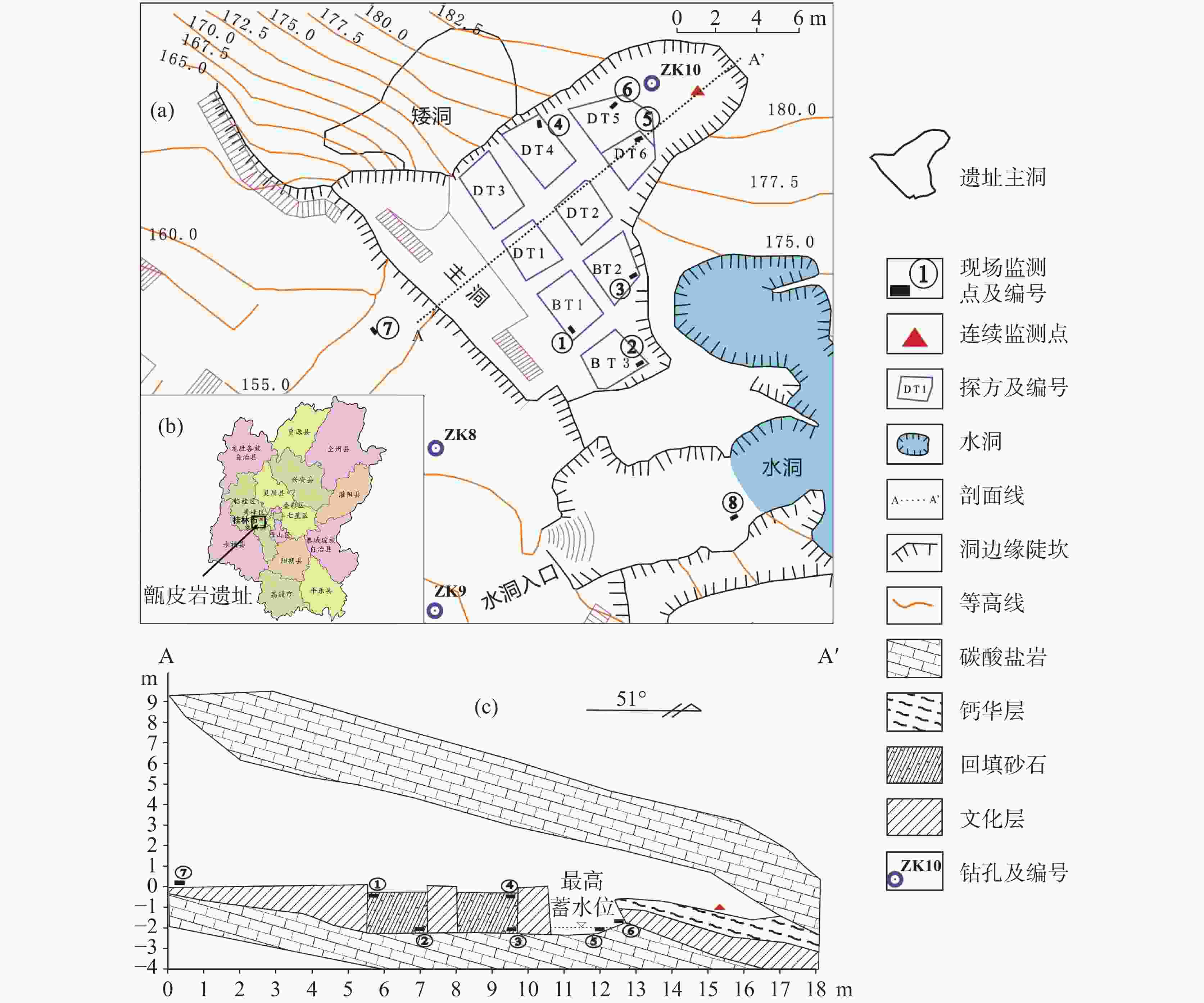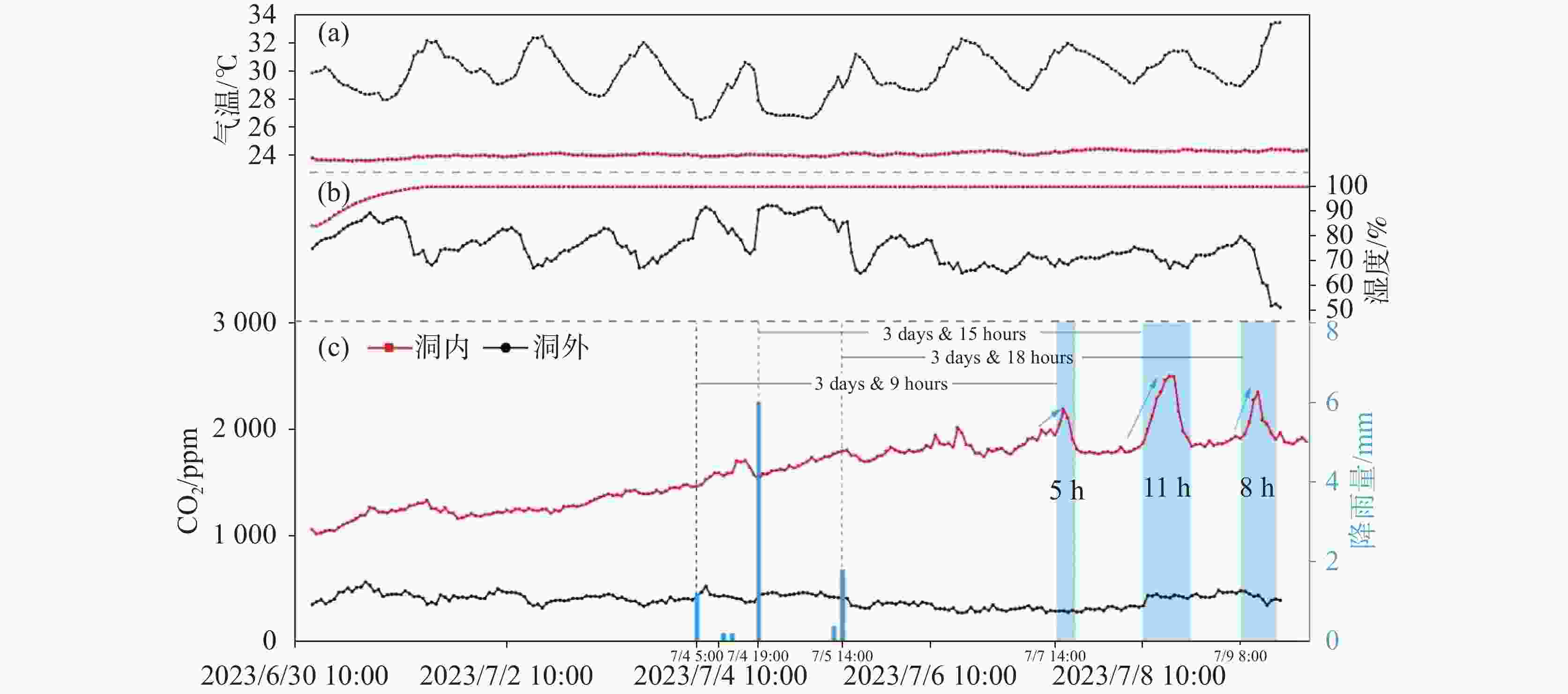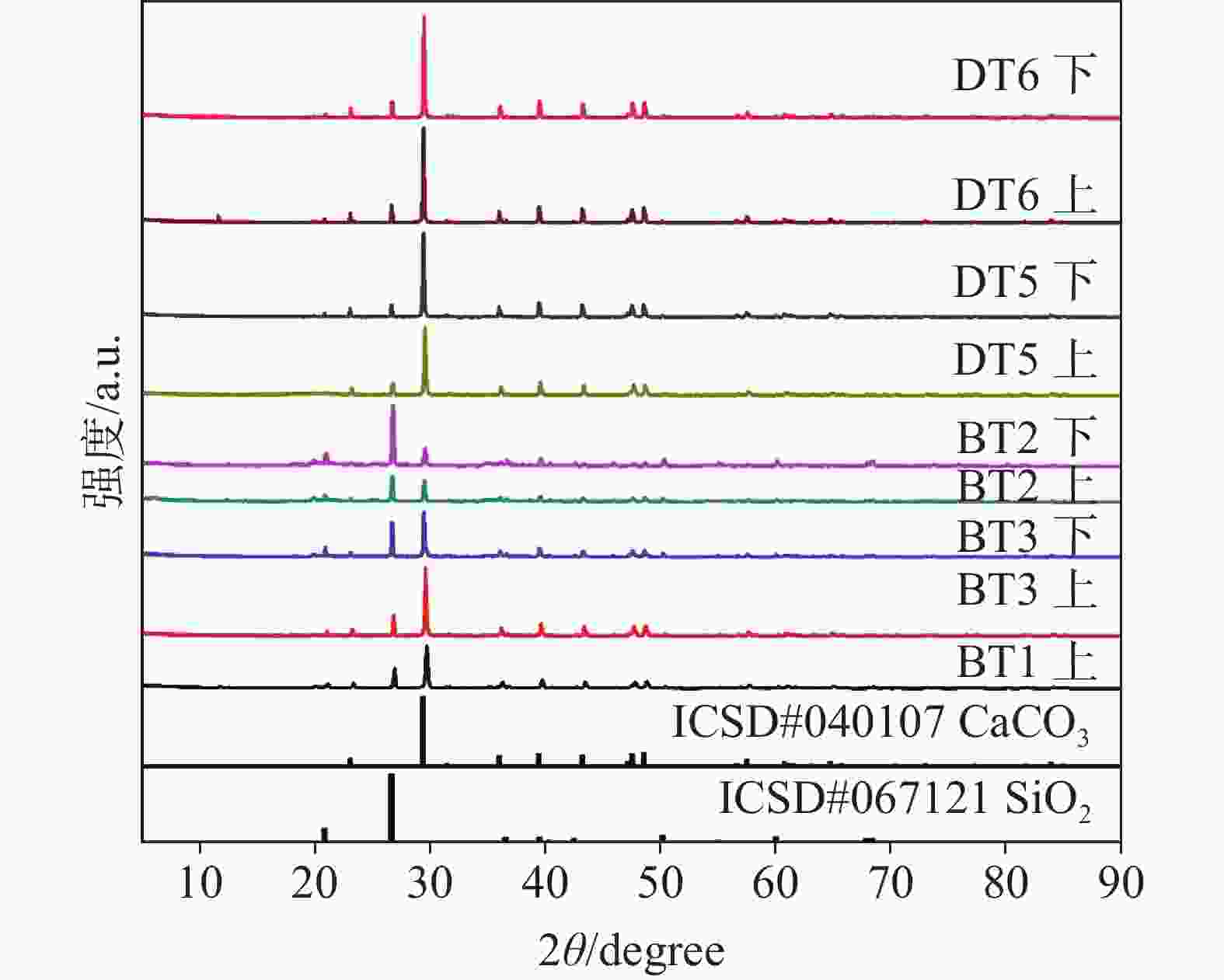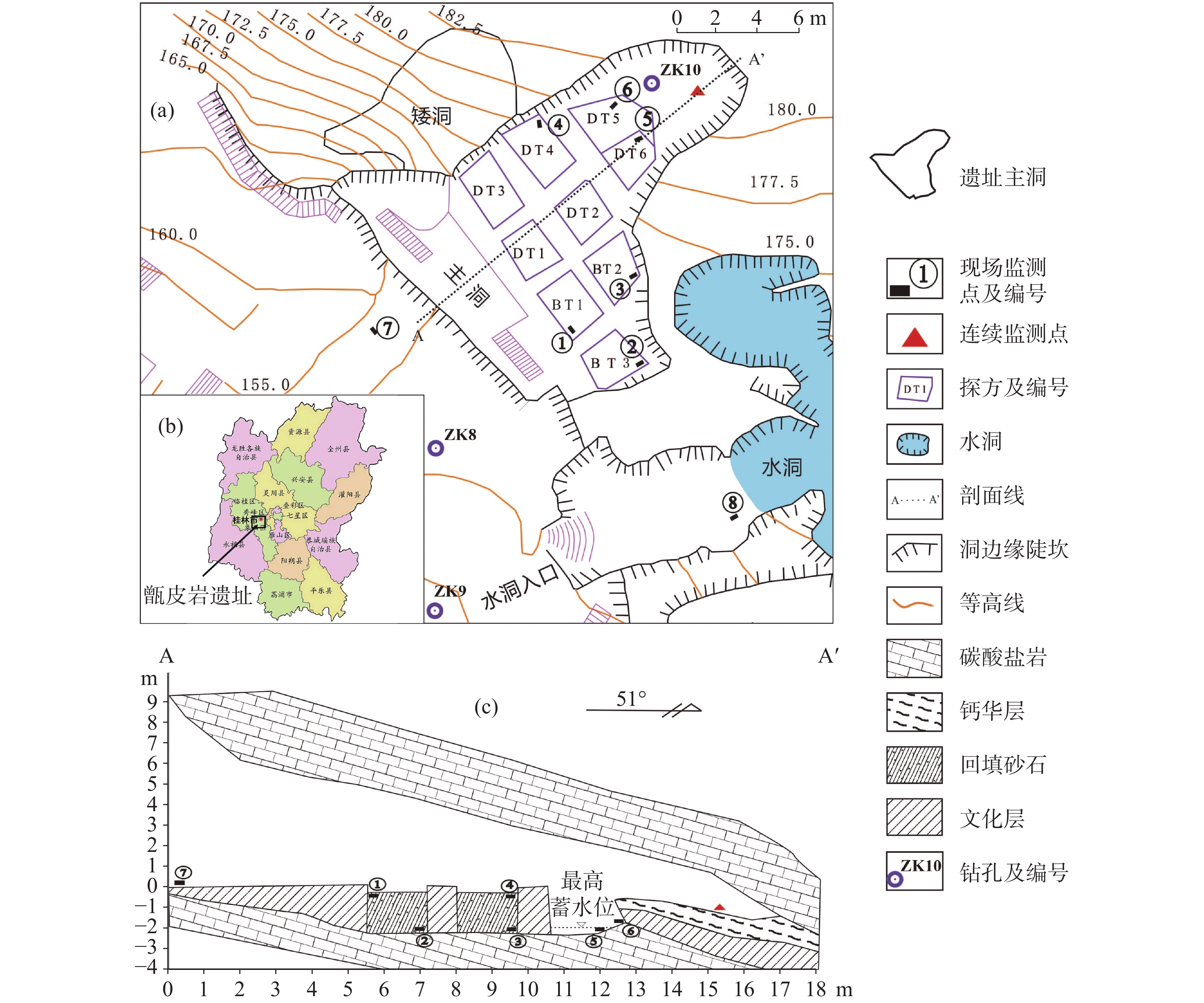Changes of air environmental factors in Zengpiyan cave site and its influence on the cultural layers
-
摘要: 甑皮岩古人类遗址洞穴内原始文化层的保存是遗址保护的重中之重。为了解洞内空气环境因子变化及其对遗址文化层风化的影响,选择洞穴温度、湿度以及二氧化碳(CO2)等环境因子进行为期一个水文年的观测。结果发现洞内空气环境因子随季节呈现三个阶段的变化:冬季温湿度低,变幅大,洞底CO2不累积;夏季温湿度高,变幅小且稳定,CO2在洞底累积;春秋为两者过渡阶段。空间上,温湿度随着洞穴深度的变化而呈现渐进式变化。CO2在洞穴东部有着高浓度带状的分布区域,表明水洞是主洞CO2的重要来源。综合分析认为通风效应、洞穴形态、旅游活动等是影响洞穴空气环境变化的重要因素。观察并结合X射线衍射分析发现,近洞口、水洞连接处、洞穴中段、洞底以及探方上下部等各处文化层之间,有明显的风化程度差异,与空气环境因子的时空变化有关。如洞底探方上部文化层溶蚀空洞较多,主要是由于水蒸气在上部堆积,易凝结溶蚀并带走文化层易溶组分;洞口文化层胶结物松散粉化,与洞口空气温度变幅较大、干湿交替频繁有关。本研究掌握了具有浅平开阔洞口特征的甑皮岩遗址主要环境因子的时空变化,探讨了可能的影响因素和对文化层风化的影响,为洞穴遗址更好的保护和利用提供了科学依据。Abstract:
The Zengpiyan cave site is a significant Neolithic cave site in Southern China, yielding complete human skeletal fossils as well as artifacts related to the diet and tools of ancient human inhabitants. This cave site provides essential evidence for understanding human activities in Southern China between 12,000 and 7,000 years ago. The cave system at the site consists of three distinct areas: the main cave, the water cave, and the low cave. The main cave retains an intact original cultural layer, featuring clear stratigraphic sequences. Cultural layers, representing the area where artifacts are preserved within the cave site, embody the most important cultural content of the site. Previous research on karst caves has shown that temperature, relative humidity, and carbon dioxide (CO2) concentrations inside the cave exhibit markedly different temporal and spatial variations compared to the outside environment. These factors influence the formation and degradation of carbonate deposits such as stalactites. To understand the temporal and spatial variations of air environmental factors within the Zengpiyan cave site and their influence on the weathering of cultural layers, this study acts as a crucial supplement and extension to the environmental research on the Zengpiyan cave site, with a particular emphasis on the microenvironment of the cultural layers of the cave. The study specifically examines environmental factors such as cave temperature, relative humidity, and CO2 concentrations. A hydrological year-long observation was conducted in Zengpiyan cave with the use of various air monitoring devices, along with the sampling and analysis of cultural layer deposits from different excavation units. The results reveal that the air environmental factors inside the cave exhibit three distinct seasonal stages: in winter, both temperature and humidity are low with large fluctuations, and CO2 does not accumulate at the cave floor. In contrast, summer, brings high temperature and humidity with small and stable variations, resulting in CO2 accumulation at the cave floor. Spring and autumn serve as transitional phases between winter and summer. Spatially, temperature and humidity show a gradual variation with the increase of cave depth. CO2 concentrations exhibited a banded distribution with high-concentrations in the eastern section of the cave, suggesting that the water cave plays a significantly role in evevating the CO2 levels within the main cave. The primary source of CO2 in the cave is the overlying soil, with rainfall events identified as critical triggers for peak CO2 levels within the cave. A comprehensive analysis suggests that ventilation effects are the main factors influencing the temporal and spatial variations of air within the cave. Additionally, cave morphology and tourism activities are also recognized as significant contributors to the air environment within the cave. Observing and combining X-ray diffraction analysis, it was found that there are significant differences in the degree of weathering of cultural layers near the entrance of the cave, water cave connections, cave middle sections, cave bottoms, and the upper and lower parts of the exploration area, which are related to the spatiotemporal changes of air environmental factors. For example, there are more dissolution cavities in the upper cultural layer at the cave floor, mainly due to the accumulation of water vapor in the upper part, which condenses and dissolves, transporting easily soluble components away from the cultural layer. In contrast, the cultural layer at the cave entrance is characterized by loose and powdery cementation, which is associated with the significant temperature fluctuations and frequent cycles of drying and wetting at the entrance. This study has documented the temporal and spatial variations of the main air environmental factors at the Zengpiyan cave site, which is characterized by a shallow, wide-open entrance. It has also explored the potential influencing factors and their impact on the weathering of cultural layers. These findings provide a scientific basis for the improved preservation and utilization of cave sites. -
Key words:
- cave sites /
- air environment /
- weathering of cultural layer /
- CO2 /
- Zengpiyan
-
图 12 文化层的主要风化状态
左:DT6探方疏松多孔上部文化层 中:DT6探方致密紧实下部文化层 右: 近洞口文化层文物干裂
Figure 12. Principal weathering conditions of the cultural layer
Left: the loose and porous upper cultural layer of DT6; Middle: the compact lower cultural layer of DT6; Right: the relic drying splits in the cultural layer near the cave entrance
表 1 测点简介表
Table 1. Introduction of monitoring points
分类 编号 位置 探方深/m 洞口距离/m 洞穴形态、沉积物、环境 近洞口 ① BT1 0.2 4.5 高且宽阔的洞口,回填砂土以及暴露在外松散的原始堆积,长期有照明设施 水洞连接 ② BT3 1.5~1.8 6.8 主洞与水洞连接通道,洞顶发育有较多鹅管,雨季有长期滴水 洞穴中段 ③ BT2 1.3~1.6 8.5 洞穴高度和宽度都有所收缩,东侧洞壁发育有较多钟乳石,雨季有滴水 ④ DT4 0.2 9.5 较宽阔洞穴中部,近矮洞有小型凹槽,回填砂土覆盖 洞底 ⑤ DT6 2.68 13.1 近水洞深坑,堆积潮湿黏土,坑底雨季蓄水淹没文化层 ⑥ DT5 1.97~2.47 13.9 有较狭窄向内凹槽,原始堆积,雨季滴水汇聚成水流流经 其他 ⑦ 洞口外 \ 洞口外开阔地,自然堆积 ⑧ 水洞 \ 小洞口洞厅,外部有钙华,内部松软水池底泥,洞内存在地下河,降雨期有大量滴水 ▲ 连续监测 15.9 狭窄洞底,存在未挖掘的原始堆积,雨季有滴水 备注:①测试点为近洞口BT1探方测试点;②测点为水洞连接BT3探方测点;③、④测点为洞穴中段BT2、DT4探方测点;⑤、⑥测点为洞底DT6、DT5探方测点;⑦为洞口外测点;⑧为水洞测点。
Note: ① measuring point of BT1 near the entrance of the cave; ② measuring point that connects water cave with measuring point of BT3 ; ③ and ④ measuing points of BT2 and DT4 in the middle of the cave; ⑤ and ⑥ measuring points of DT6 and DT5 at the cave floor; ⑦ measuring point outside the cave; ⑧ measuring point of the water cave.表 2 洞穴温度、湿度和CO2观测结果统计表
Table 2. Statistics of observations on cave temperature, humidity, and CO2 levels
指标/单位 ① ② ③ ④ ⑤ ⑥ ⑦ ⑧ 年平均值 T/ ℃ 22.6 22.2 21.7 21.4 21.1 21.2 22.8 22.0 RH/% 73.6 74.2 77.5 75.0 81.7 78.0 72.6 83.1 CO2/×10−6 509 633 575 469 583 520 429 1 042 年最大值 T/ ℃ 29.3 28.0 27.8 27.9 27.5 27.4 30.7 27.9 RH/% 93.7 91.1 92.7 94.6 94.5 94.3 95.3 99.5 CO2/×10−6 617 1 097 1 264 519 787 642 456 2 789 年最小值 T/ ℃ 13.7 12.7 12.1 11.5 11.8 11.5 8.0 15.6 RH/% 45.2 50.4 46.8 44.3 57.2 46.7 46.3 55.6 CO2/×10−6 410 419 421 415 478 471 394 448 年变幅 T/ ℃ 15.6 15.3 15.7 16.4 15.7 15.9 22.7 12.3 RH/% 48.5 40.7 45.9 50.3 37.3 47.6 49.0 43.9 CO2/×10−6 207 678 843 104 309 171 62 2 341 观测次数 N 11 11 11 11 11 11 11 10 表 3 T、RH、CO2垂直分布变化表
Table 3. Vertical distributions of T, RH and CO2
位置 BT3(②) BT2(③) DT5(⑥) DT6(⑤) 上部 下部 上部 下部 上部 下部 上部 下部 顶底高差/m 1.80 1.60 1.97 2.68 7月29日 T/ ℃ 27.0 27.9 28.1 27.8 27.5 27.4 27.1 27.5 RH/% 86.1 82.1 82.9 84.7 83.8 82.6 87.2 81.1 CO2/×10−6 530 730 493 562 529 568 592 787 8月25日 T/ ℃ 26.1 27.2 26.4 26.7 25.9 26.0 25.8 25.7 RH/% 94.3 91.1 93.9 92.7 93.0 94.3 96.3 94.5 CO2/×10−6 861 1 097 896 1 264 658 642 605 786 9月26日 T/ ℃ 26.1 26.6 26.7 26.5 26.4 26.7 25.9 26.2 RH/% 86.4 83.9 86.0 88.0 85.5 85.3 89.1 87.7 CO2/×10−6 645 788 552 612 457 556 464 711 -
[1] Jiang G, Guo F, Wei M. Hydrogeological characteristics of foot caves in a karst peak-forest plain in South China[J]. Hydrogeology Journal, 2020, 28(2): 535-548. doi: 10.1007/s10040-019-02096-8 [2] 黄文化. 桂林甑皮岩遗址地下水害防治工程水文地质试验[J]. 西部探矿工程, 2019, 31(1):125-127, 130. doi: 10.3969/j.issn.1004-5716.2019.01.044 [3] Guo F, Jiang G H, Liu F. Biological sulfate reduction in an epigene karst aquifer and its impact on cave environment[J]. Journal of Hydrology, 2021, 602: 126804. doi: 10.1016/j.jhydrol.2021.126804 [4] Bao J, Wu X S, Zhang Q, Yuan D X, Guo F, Liu F. Unveiling the nitrogen transport and transformation in different karst aquifers media[J]. Journal of Hydrology, 2023, 620: 129335. doi: 10.1016/j.jhydrol.2023.129335 [5] 张美良, 朱晓燕, 覃军干, 吴夏, 曹建华. 桂林甑皮岩洞穴的形成、演化及古人类文化遗址堆积浅议[J]. 地球与环境, 2011, 39(3):305-312.ZHANG Meiliang, ZHU Xiaoyan, QIN Jungan, WU Xia, CAO Jianhua. Primary research on the formation and development of Zengpiyan cave and the ancient cultural layer at the Zengpiyan archaeological site, Guilin, China[J]. Earth and Environment, 2011, 39(3): 305-312. [6] 班凤梅, 蔡炳贵. 北京石花洞空气环境主要因子季节性变化特征研究[J]. 中国岩溶, 2011, 30(2):132-137. doi: 10.3969/j.issn.1001-4810.2011.02.003BAN Fengmei, CAI Binggui. Research on seasonal variations of the air's main environmental factors in the Shihua cave, Beijing[J]. Carsologica Sinica, 2011, 30(2): 132-137. doi: 10.3969/j.issn.1001-4810.2011.02.003 [7] 袁道先, 蔡桂鸿. 岩溶环境学[M]. 重庆:重庆出版社, 1988. [8] 方雨, 蒋忠诚, 张卫, 章程. 岩溶作用过程试验方法研究:以岩溶作用仪研制为例[J]. 中国岩溶, 2023, 42(1):40-51. doi: 10.11932/karst20230103FANG Yu, JIANG Zhongcheng, ZHANG Wei, ZHANG Cheng. Study on test method of karstification process: Take the development of karstification instrument as an example[J]. Carsologica Sinica, 2023, 42(1):40-51. doi: 10.11932/karst20230103 [9] 石亮星, 周忠发, 范宝祥, 汤云涛, 闫利会, 安丹, 朱粲粲. 喀斯特洞穴通风效应特征变化及其对洞内空气环境的影响研究:以贵州绥阳麻黄洞为例[J]. 长江流域资源与环境, 2021, 30(7):1704-1713.SHI Liangxing, ZHOU Zhongfa, FAN Baoxiang, TANG Yuntao, YAN Lihui, AN Dan, ZHU Cancan. Characteristics of ventilation effect in karst caves and its influence on cave air environment: A case study of Mahuang cave of Suiyang, Guizhou Province[J]. Resources and Environment in the Yangtze Basin, 2021, 30(7): 1704-1713. [10] Milanolo S, Gabrovšek F. Analysis of carbon dioxide variations in the atmosphere of Srednja Bijambarska cave, Bosnia and Herzegovina[J]. Boundary-Layer Meteorology, 2009, 131(3): 479-493. doi: 10.1007/s10546-009-9375-5 [11] Sánchez Cañete E P, Serrano Ortiz P, Domingo F, Kowalski A S. Cave ventilation is influenced by variations in the CO2-dependent virtual temperature[J]. International Journal of Speleology, 2013, 42(1): 1-8. doi: 10.5038/1827-806X.42.1.1 [12] 宋林华, 韦小宁, 梁福源. 河北临城白云洞洞穴旅游对洞穴CO2浓度及温度的影响[J]. 中国岩溶, 2003, 22(3):230-235.SONG Linhua, WEI Xiaoning, LIANG Fuyuan. Effect of speleo-tourism on the CO2 content and temperature in Baiyun cave, Lincheng, Hebei[J]. Carsologica Sinica, 2003, 22(3): 230-235. [13] 卫敏洁. 甑皮岩洞穴遗址地下水的水—气界面侵蚀性气体的产生机理[D]. 重庆:西南大学, 2020.WEI Minjie. Production mechanism of corrosive gas at the water-air interface of groundwater at Zengpiyan cave site in Guilin[D]. Chongqing: Southwest University, 2020. [14] 潘艳喜. 喀斯特洞穴空气要素变化特征及其对洞穴环境的影响研究:以贵州织金洞为例[D]. 贵阳:贵州师范大学, 2020.PAN Yanxi. Study on the characteristics of air elements variety in karst cave and its impact on the cave environment: A case study of Zhijin cave, Guizhou Province[D]. Guiyang: Guizhou Normal University, 2020. [15] 蔡炳贵, 沈凛梅, 郑伟, 李克普, 白云志, 董春志. 本溪水洞洞穴空气CO2浓度与温、湿度的空间分布和昼夜变化特征[J]. 中国岩溶, 2009, 28(4):348-354. doi: 10.3969/j.issn.1001-4810.2009.04.004CAI Binggui, SHEN Linmei, ZHENG Wei, LI Kepu, BAI Yunzhi, DONG Chunzhi. Spatial distribution and diurnal variation in CO2 concentration, temperature and relative humidity of the cave air: A case study from Water cave, Benxi, Liaoning, China[J]. Carsologica Sinica, 2009, 28(4): 348-354. doi: 10.3969/j.issn.1001-4810.2009.04.004 [16] 吴天太. 空气密度年变化情况对风电场发电量计算的影响[J]. 太阳能, 2023(4):22-29.WU Tiantai. Influence of annual variation of air density on power generation capacity calculation of wind farm[J]. Solar Energy, 2023(4): 22-29. [17] 薛冰清, 张结, 汪炎林, 周忠发, 张昊天, 汤云涛. 贵州双河洞空气环境主要因子化特征及影响因素分析[J]. 环境科学与技术, 2019, 42(2):81-88.XUE Bingqing, ZHANG Jie, WANG Yanlin, ZHOU Zhongfa, ZHANG Haotian, TANG Yuntao. Variation characteristics and causes of main factors of air environment of Shuanghe cave in Guizhou Province[J]. Environmental Science & Technology, 2019, 42(2): 81-88. [18] 殷超, 周忠发, 曹明达, 张 结, 张 强, 张绍云, 潘艳喜. 岩溶洞穴内气候环境因子关系分析:以贵州省织金洞为例[J]. 中国岩溶, 2016, 35(4):414-424.YIN Chao, ZHOU Zhongfa, CAO Mingda, ZHANG Jie, ZHANG Qiang, ZHANG Shaoyun, PAN Yanxi. Analysis on the relationship between climatic and environmental factors in karst caves: An example from Zhijin cave of Guizhou Province[J]. Carsologica Sinica, 2016, 35(4): 414-424. [19] 傅寒晶, 简星, 梁杭海. 硅酸盐化学风化强度评估的沉积物指标与方法研究进展[J]. 古地理学报, 2021, 23(6):1192-1209. doi: 10.7605/gdlxb.2021.06.076FU Hanjing, JIAN Xing, LIANG Hanghai. Research progress of sediment indicators and methods for evaluation of silicate chemical weathering intensity[J]. Journal of Palaeogeography, 2021, 23(6): 1192-1209. doi: 10.7605/gdlxb.2021.06.076 [20] 朱学稳, 汪训一, 朱德浩, 龚自珍, 覃厚仁. 桂林岩溶地貌与洞穴研究[M]. 北京:地质出版社, 1988. [21] Fernando Gázquez, José María Calaforra, Paolo Forti, Jo De Waele, Laura Sanna. The role of condensation in the evolution of dissolutional forms in gypsum caves: Study case in the karst of Sorbas (SE Spain)[J]. Geomorphology, 2015, 229: 100-111. [22] Houillon N, Lastennet R, Denis A, Malaurent P, Minvielle S, Peyraube N. Assessing cave internal aerology in understanding carbon dioxide (CO2) dynamics: Implications on calcite mass variation on the wall of Lascaux Cave (France)[J]. Environmental Earth Sciences, 2017, 76(4): 170. doi: 10.1007/s12665-017-6498-8 [23] 易泉. 干旱区土遗址风化特征及劣化模型研究[D]. 兰州:兰州大学, 2023.YI Quan. Deterioration model for earthen monuments in arid weathering condition[D]. Lanzhou: Lanzhou University, 2023. [24] 陈毅, 张虎元, 杨龙. 遗址土劣化进程中微观结构变化的类比研究[J]. 岩土力学, 2018, 39(11):4117-4124, 4141.CHEN Yi, ZHANG Huyuan, YANG Long. Analogy study on evolution of microstructure of earthen monument during natural weathering process[J]. Rock and Soil Mechanics, 2018, 39(11): 4117-4124, 4141. -





 下载:
下载:













